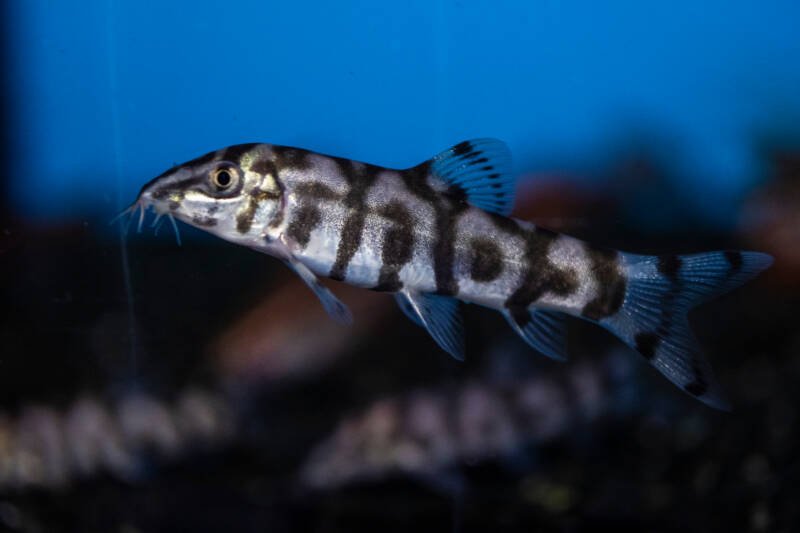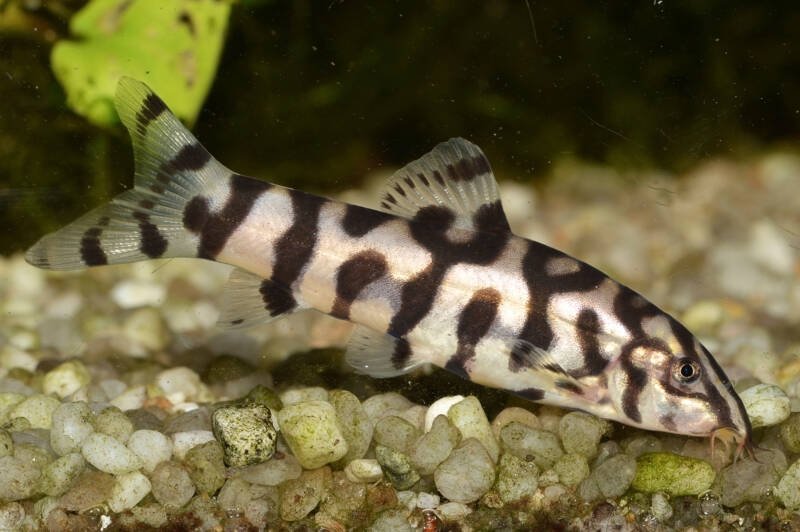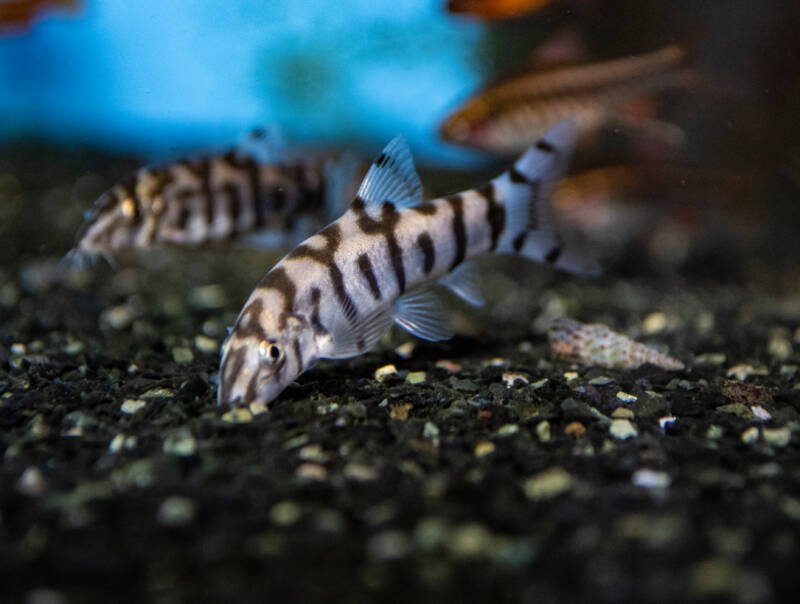A fun pattern, active behavior, and playful nature: these are the traits of the yoyo loach.
This member of the Botia genus is unique for its daytime antics.
While most species of loach are resting, this one is swimming up and down the water column, bouncing like a yoyo, and tirelessly searching for food.

This fish is also well known for its appearance.
When yoyo loaches are young, their stripes form shapes resembling the letters Y and O, stamping their common name down their lateral line!
As they age, the lines spread, and they are often called a reticulated loach due to this pattern.
This fish pairs well with many other species in a community tank, making it highly sought after in the aquarium hobby.
The scientific name for the yoyo loach is (Botia almorhae), but you will frequently find it referred to as the Pakistani loach or almora loach.
Read on for more information on the care and feeding of this fish, including how to set up the perfect tank environment.
At a Glance
| Tank Size: | 40 gallons |
| Group Size: | 4 – 5 minimum |
| Water Temperature: | 75 – 82°F (24 to 28°C) |
| pH: | 6.5 – 7.5 |
| Hardness: | 3 – 12 dGH |
| Lifespan: | 5 – 8 years |
| Breeding: | Challenging in an aquarium environment |
| Adult Size: | 2.5 inches (6.4 cm) |
| Usual Place in the Tank: | Middle to bottom |
In this article
Natural Habitat
The yoyo loach comes from the waters of northern India and Pakistan, as well as Nepal. One can find them in large numbers in the Ganges basin region.
Their native waters are clean, warm, and soft, as well as slightly acidic.
Although they are slow-moving waters, they are high in oxygen content.
Yoyo loaches migrate during their lifetime, moving between baren and rocky environments to those that are sandy and heavy with vegetation.
Their migrations mean that they have adapted to a range of water conditions.
Appearance and Biology

Most of the yoyo loach specimens you see will have a silver-colored base, but some can appear more yellow or gold.
Covering their back is the characteristic, interlacing Y and O pattern. This pattern varies from fish to fish and depends on the fish’s age.
When they are young, the lines can clearly form the letter shapes, but as the fish age, these lines broaden into a more net-like pattern.
Yoyo loach bodies are long, slender, and flat on the bottom, which is favorable as they spend a good amount of time scooting along the riverbed.
Their heads are cone-shaped, with a protruding snout. At the end of their snout are four sets of barbels around their mouths that they use in their never-ending search for food.
Size
The yoyo loach reaches an adult size of 2.5 inches (6.4 cm).
If they live in the wild or are kept in a large aquarium, this species can grow larger, to almost six inches in length (15 cm).
Lifespan
A yoyo loach can be a part of your tank for five to eight years.
If you are looking for a challenge, some aquarists have reported a 20-year lifespan for their loaches!
These longer lifespans are the result of extraordinary care, a healthy environment, and a large tank.
Behavior
Aside from their good looks, aquarists love these fish for their behavior.
Yoyo loaches tend to be significantly more active than your typical loach.
We have mentioned their “yoyo”-like behavior, playfully bouncing up and down the water column.
They also love to explore their environment and are constantly moving around the sand to find a bite to eat.
Although newly introduced loaches can be a bit shy, it will not be long before they become comfortable and more playful.
They are also active during the daytime, which is a plus for an aquarist who wants a fish they can see during the day.
Yoyos love to interact with other species in the tank and are peaceful toward their tank mates.
These fish do not school, but they still need the company of their own for optimum health, thus the recommendation for a group size of at least four or five.

You may notice that your loaches will group up and “play” together, then separate to do their own thing.
There can be infighting among the yoyos, and dominant ones may pick on weaker ones if your school size is too small.
This aggression usually does not extend to other species in the tank.
How many per gallon?
When these fish are young, you can get away with keeping a single fish in a 20- to 30-gallon tank (76-114 l).
However, as they grow, plan on a 40-gallon (150 l) tank to hold a single adult.
Remember that this fish needs a group of four to five of its species as tankmates.
Add 15 gallons (57 l) of water for each additional loach in the tank. For a group of five, then, you would need a 100-gallon tank (378 l).
Tank Setup
Setting up a tank to accommodate yoyo loaches is simple.
These fish do not have any unique needs beyond sand, stable water, plants, and a place to hide.
Decorations
As these fish tend to dig around in the substrate, choose a soft sand to line the tank bottom.
Anything harder, such as gravel, could damage the loach’s sensitive barbels.
Place pieces of driftwood and rocks around the bottom but leave plenty of swimming space.
Set up cave-like structures that are around the same size as your loach – they love a cozy cave.
This fish does well in a planted tank.
Select plants that you can anchor or place them in pots to prevent your loach from uprooting. Place these plants around the tank edges.
Water Conditions
The yoyo loach tolerates a decent range of water conditions. Just remember to keep them consistent to reduce stress to your fish.
Remember that this species likes warm, soft, acidic water.
Yoyo loaches do best in the following water conditions:
- Temperature: 75 – 82°F (24 to 28°C)
- pH: 6.5 to 7.5
- Hardness: 3 to 12 dGH
Change out at least 15 percent of the water every week to keep the tank clean.
Equipment
Equipment needs for keeping these fish in an aquarium are minimal.
Because yoyo loaches spend a good portion of their lives in waters with minimal current, install a filter with a low flow rate or break up the flow using plants or other obstacles.
Moderate to dim lighting is perfect.
These fish are sensitive to shifts in water parameters, so a good testing kit is a sound investment.
Tank Mates

Aside from stable water conditions, the best thing you can do for your yoyo loach is to give them some company.
Yoyo loaches are a species that NEEDS to have other fish in their tank.
Keeping them as a single specimen will cause excessive stress and may make them susceptible to disease or prone to aggression.
In addition to other species in the tank, do not overlook the importance of having multiple yoyo loaches as well.
Yoyo needs others of its kind with which to bond in order to be healthy.
Consider these species to pair with your yoyo loach:
- More yoyo loaches (a group of four to five is best)
- Fish of equivalent size
- Fish that stay in the middle or upper levels of the water column
- Peaceful bottom dwellers
- Smaller schooling or shoaling fish
Avoid the following:
- Aggressive fish
- Overly timid bottom dwellers (the yoyo may annoy them)
- Smaller ornamental snails (the yoyo may eat them)
Food and Diet
In the wild, this species prefers insects and loves mosquito larvae.
However, these omnivores will eat whatever is available, including vegetable matter.
In an aquarium, they will readily eat flake, frozen, and freeze-dried foods. Select foods that will sink to the bottom so that your loach gets the nutrition it needs.
They love protein-rich foods like bloodworms, daphnia, and brine shrimp but do not forget the importance of plant matter.
Toss in some algae wafers every now and then to round out their diet.
Feed your fish several small meals each day to keep them from overeating.
Adjust the amount of food you are giving if you find consistently too much leftover after a few minutes.
Breeding
Breeding yoyo loaches is difficult in an aquarium environment.
This species migrates to breed, and ideal conditions are challenging to recreate.
Some professional breeders have had success, but you will find most of the yoyo loaches on the market are wild-caught.
Hardiness and Diseases
This fish has small scales that make it more susceptible to infection by parasites or fungus.
They are also sensitive to medications or chemicals in the water. So the first indication that something is infecting your tank may be that your loaches are becoming ill.
Read up on common freshwater tank ailments and learn to recognize the symptoms of such diseases as ich.
Remove any sick fish from the community tank and treat them with over-the-counter medication in the water.
Correct any water conditions in the community tank that may have contributed to the disease.
Frequently Asked Questions
Can angelfish live with yoyo loaches?
There is a split in opinion on this pairing.
Many respondents state that they have successfully kept this combination with no problems between angels and loaches.
Others have noted that the high activity level of the yoyo loaches may bother the slower moving angels, so it may come down to the individual personalities of the fish.
Yoyos are known to play somewhat boisterously and appear to nip at each other’s fins.
This behavior does not usually extend to other species in the tank.
As with any pairing, monitor interactions among the fish and adjust the mix as needed.
Can yoyo loaches live with guppies?
You can pair yoyo loaches with guppies, but make sure that their habitat is suitable.
It is important to reduce environmental stressors so that the loaches do not become aggressive toward the guppies.
Keep your fish in a large tank with plenty of hiding spaces for the loaches.
Feed them regularly and maintain stable water conditions.
What is a good yoyo loach school size?
A minimum group size of four to five loaches is ideal.
This size spreads out any potential aggression and reduces the chance that one of the loaches will be singled out and picked on.
How do you tell a yoyo loach male versus female?
It can be challenging to determine which of your fish are male and female.
Male yoyos are generally more slender than females, which will appear rounder when carrying eggs.
Male yoyos may have a splash of red around their barbels.
Closing Thoughts
The yoyo loach is, without a doubt, an excellent addition to a home aquarium.
They are hardy, easy to feed, and tolerant of various water conditions.
Yoyos are good community tank members that can pair with other species of comparable size and temperament.
You can purchase these fish singly or in groups at prices ranging from $3.50 to $8.00.
With proper care, these active bottom dwellers will surely provide years of entertainment and beauty!
If you have kept yoyo loaches in your home aquarium, we would love to hear from you!
What tank mates do your loaches get along with best?